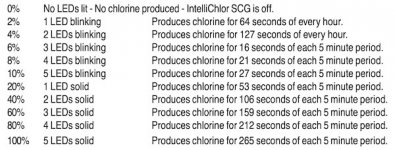- Nov 12, 2017
- 11,834
- Pool Size
- 12300
- Surface
- Plaster
- Chlorine
- Salt Water Generator
- SWG Type
- Pentair Intellichlor IC-40
I actually made a couple corrections in my earlier post, because I had written it wrong. But I still think you can do what you need without adding anything, electrically or physically.
You should be bracketing around your SWG runtime, in case the timer gets out of sync with the pump. I'll use an example to explain.
Let's say your SWG's minimum flow requirement needs 1500 RPM to get a green flow LED.
And let's say you need 7 hours and 15 minutes of SWG runtime to get the perfect amount of chlorine each day.
- Program your Intermatic timer to run the SWG for 8 hours a day, from 9:00AM to 5:00PM.
- Program your IntelliFlo to schedule a run for 10 hours a day at 1200 RPM, from 8:00AM to 6:00PM ("bracketing" around the Intermatic runtime).
- Create a second IntelliFlo schedule for 7.25 hours a day at 1600 RPM, from 9:30AM to 4:45PM.
Your pump will run for 10 hours.
Your SWG will power on for 8 hours, within the pump's runtime.
Your pump will ramp up to 1600 RPM for 7.25 hours a day, which will trigger the SWG to produce chlorine for 7.25 hours, within the Intermatic's runtime.
You can fine tune the chlorine production by adjusting up or down that second IntelliFlo schedule, in five minute increments more or less. Even after you get the perfect runtime figured out, you'll then need to adjust for the seasons: more runtime for the middle of summer, less for spring and fall, etc. But you'd do all that by adjusting just that second IntelliFlo schedule.
The Intermatic timer keeps the SWG from firing outside of the IntelliFlo runtime. You've got an hour of pump runtime on either side of the Intermatic runtime, in case the Intermatic gets out of time sync with the IntelliFlo. And the SWG chlorine production (the 1600 RPM run, which triggers the SWG's flow requirement) runs within both the pump runtime and the Intermatic runtime.
So a power failure will trash the Intermatic runtime, but that's a problem you've currently got, so the scheme above doesn't make that any better or worse. The correct way to address that is to install a secondary flow switch, or a power-sensing relay, which are not hard to do. Or you can just run your IntelliFlo 24-7 at a very low RPM, so that no matter when the out-of-sync Intermatic decides to run your SWG, you'll always have water flowing through it.
But either way, the scheme above will work with your current equipment, at least until you decide to go with some sort of home automation solution, or a more advanced pool automation controller. Now if you want remote control, that's a whole 'nother can'o'worms.
You should be bracketing around your SWG runtime, in case the timer gets out of sync with the pump. I'll use an example to explain.
Let's say your SWG's minimum flow requirement needs 1500 RPM to get a green flow LED.
And let's say you need 7 hours and 15 minutes of SWG runtime to get the perfect amount of chlorine each day.
- Program your Intermatic timer to run the SWG for 8 hours a day, from 9:00AM to 5:00PM.
- Program your IntelliFlo to schedule a run for 10 hours a day at 1200 RPM, from 8:00AM to 6:00PM ("bracketing" around the Intermatic runtime).
- Create a second IntelliFlo schedule for 7.25 hours a day at 1600 RPM, from 9:30AM to 4:45PM.
Your pump will run for 10 hours.
Your SWG will power on for 8 hours, within the pump's runtime.
Your pump will ramp up to 1600 RPM for 7.25 hours a day, which will trigger the SWG to produce chlorine for 7.25 hours, within the Intermatic's runtime.
You can fine tune the chlorine production by adjusting up or down that second IntelliFlo schedule, in five minute increments more or less. Even after you get the perfect runtime figured out, you'll then need to adjust for the seasons: more runtime for the middle of summer, less for spring and fall, etc. But you'd do all that by adjusting just that second IntelliFlo schedule.
The Intermatic timer keeps the SWG from firing outside of the IntelliFlo runtime. You've got an hour of pump runtime on either side of the Intermatic runtime, in case the Intermatic gets out of time sync with the IntelliFlo. And the SWG chlorine production (the 1600 RPM run, which triggers the SWG's flow requirement) runs within both the pump runtime and the Intermatic runtime.
So a power failure will trash the Intermatic runtime, but that's a problem you've currently got, so the scheme above doesn't make that any better or worse. The correct way to address that is to install a secondary flow switch, or a power-sensing relay, which are not hard to do. Or you can just run your IntelliFlo 24-7 at a very low RPM, so that no matter when the out-of-sync Intermatic decides to run your SWG, you'll always have water flowing through it.
But either way, the scheme above will work with your current equipment, at least until you decide to go with some sort of home automation solution, or a more advanced pool automation controller. Now if you want remote control, that's a whole 'nother can'o'worms.


